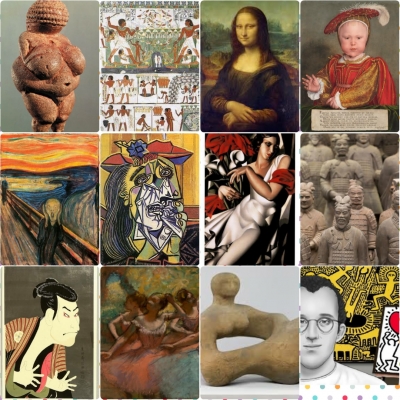
ART
Some artists seek to create a beautiful object; others use art to reveal something about the world. In the past, art also served a religious, or magical, or mystical purpose. Styles of art vary widely, and artists from different cultures have shown the human form in many different ways.
The first art This carving of a pregnant woman, found in Austria, was made 25,000 years ago. Her hair is shown in detail, yet she has no facial features.
Tomb art Egyptian painters showed each part of the body from its most distinctive angle. Heads and limbs were viewed from the sides, with eyes and torsos shown from the front.
Mona Lisa With her mysterious half-smile, this is the world’s most famous work of art. It was painted in 1503-7 by Italian artist Leonardo da Vinci.
Royal portrait German artist, Hans Holbein, was court painter to Henry VIII of England. His 1539 portrait of Henry’s son, Edward, shows the clothing in great detail.
Self-portrait Dutch artist Rembrandt van Rijn (1606-69) painted 60 self-portraits to experiment with techniques and to document his life.
Indian art This painting, made in 1770, is not a realistic image, but follows set rules. The athletes’ heads are shown in profile while their chests face out.
Emotion art In The Scream (1893), Norwegian Edvard Munch aimed to express emotion rather than depict a real scene.
New forms Spanish artist Pablo Picasso (1881–1973) took the human form apart and reassembled it in startling ways.
Art Deco Polish artist Tamara de Lempicka (1898–1980) belonged to the Art Deco movement, which saw art as purely decorative.
Self-image Mexican artist, Frida Kahlo (1907-54) painted self-portraits using scenes drawn from fantasy.
Terracotta Army In 209 BCE, more than 8,000 life-sized pottery figures of soldiers were buried to guard the tomb of China’s first emperor. Every soldier has different features.
Prayer book Medieval European art often served a religious purpose. This illustrated book depicts the Virgin Mary holding the baby Jesus.
African mask These elaborate works of art were worn for ritual dances, when the wearer communicated with spirits.
Japanese print In 1794, artist Toshusai Sharaku made this woodcut print of an actor called Otani Oniji. He is shown performing the role of a villain, grimacing threateningly.
Brush strokes Like Rembrandt, Dutch artist, Vincent Van Gogh (1853-90), painted many self-portraits, 30 of them in the last five years of his life. He had a loose style, with each brush stroke visible.
Impressionism French artist Edgar Degas (1834-1917) founded an artistic movement called Impressionism. Its aim, shown in painting of ballerinas, was to capture changing light and movement.
Sculptural curves Reducing human figures to simple curving shapes was a speciality of British sculptor Henry Moore (1898-1986).
Pop art Andy Warhol (1928-87) used subjects drawn from popular culture. In 1962, Warhol used a photo of movie star Marilyn Monroe to make screen-print.
Cartoon art US artist Keith Haring (1958-90) started his career as a graffiti artist, drawing cartoon-like figures.
Picture Credit : Google




